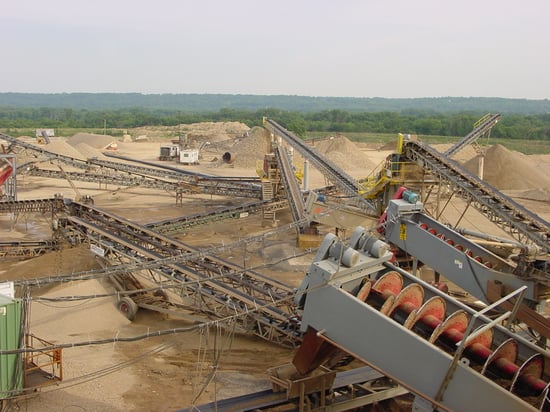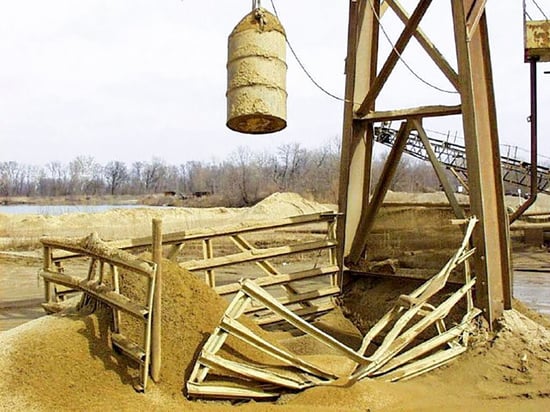By Dan Marshall on Jul 8, 2022 10:35:35 AM
I see some interesting things in my line of work in the bulk-materials handling industry. I see a lot of good, bad, and some downright ugly things. Some are more obvious than others but I like to document them in case they will help others recognize - and solve - issues.
The Good
 For some reason, I just love sand and gravel plants. They are the ultimate representation of “organized chaos.” It can look chaotic to a casual observer but to someone who is familiar, the common parts can be identified and orderly. Almost every sand and gravel plant has a primary crusher, several smaller crushers, sorting screens, and multiple stackout conveyors. Even though there are common pieces of equipment, no two plants are exactly the same. The pieces are all arranged based on needs and geography. Heck, sometimes a layout can shift every year as the pit situations change. In my mind, that makes sand and gravel pits like giant Lego kits (which I LOVE). I also view them as snowflakes. ❄️ No two are ever the same.
For some reason, I just love sand and gravel plants. They are the ultimate representation of “organized chaos.” It can look chaotic to a casual observer but to someone who is familiar, the common parts can be identified and orderly. Almost every sand and gravel plant has a primary crusher, several smaller crushers, sorting screens, and multiple stackout conveyors. Even though there are common pieces of equipment, no two plants are exactly the same. The pieces are all arranged based on needs and geography. Heck, sometimes a layout can shift every year as the pit situations change. In my mind, that makes sand and gravel pits like giant Lego kits (which I LOVE). I also view them as snowflakes. ❄️ No two are ever the same.
The Bad
![]() Given the modular and dynamic nature of the sand and gravel industry, problems sneak up on these plants. Take this belt for instance, the conveyor was moved to a new location and the belt started to mistrack. Nobody knew why a belt which had never been a problem before, was acting up now. The ground could be slightly off level, the new position may expose the conveyor to a crosswind, or an idler may have been damaged in the move. Whatever the reason, the belt is mistracking and it needs to be addressed. It would be nice if an effective and reactionary solution to keep the belt on track was available. Well, it is! This belt needs a dynamic
Given the modular and dynamic nature of the sand and gravel industry, problems sneak up on these plants. Take this belt for instance, the conveyor was moved to a new location and the belt started to mistrack. Nobody knew why a belt which had never been a problem before, was acting up now. The ground could be slightly off level, the new position may expose the conveyor to a crosswind, or an idler may have been damaged in the move. Whatever the reason, the belt is mistracking and it needs to be addressed. It would be nice if an effective and reactionary solution to keep the belt on track was available. Well, it is! This belt needs a dynamic  .
.
The Ugly
I will not go as far as to say that sand and gravel plants are perfect (proof is below) When I saw this, I knew exactly what had happened.

- They were using a DIY take-up system.
- That take-up system had fallen - at least once.
- There is a substantial amount of carryback on the belt.
- Sand and gravel operations do have a lower profit margin, so tough decisions sometimes need to be made. The take-up probably had to be replaced, but a fabricated take-up may drive their price to market up by a few cents per ton. They are more expensive than their competitors at that point, and no one will buy their stuff. They had to react with what they had on hand.
- Something catastrophic had happened in the past...either the original take-up system or the DIY take-up had fallen. The take-up needed to be repaired so they could get back in operation, and a new fence was to be ordered (as soon as they got back to their desk.) Of course, something came up before that happened and the fence was not ordered.
- A huge pile of material on one side of a take-up usually indicates that material is on the belt and knocked off by the entry idler of said take-up. This could be solved by installing a
 , but most sand and gravel operations cannot spend money at the drop of a hat. Most problems that do not stop production, end up waiting until the next budget cycle. I am not saying this is the best way to operate, but it is the reality in some situations.
, but most sand and gravel operations cannot spend money at the drop of a hat. Most problems that do not stop production, end up waiting until the next budget cycle. I am not saying this is the best way to operate, but it is the reality in some situations.
Sand and gravel operations have a unique set of problems, but there is usually more good than bad and ugly. If you liked this blog post, check out my others:







comments